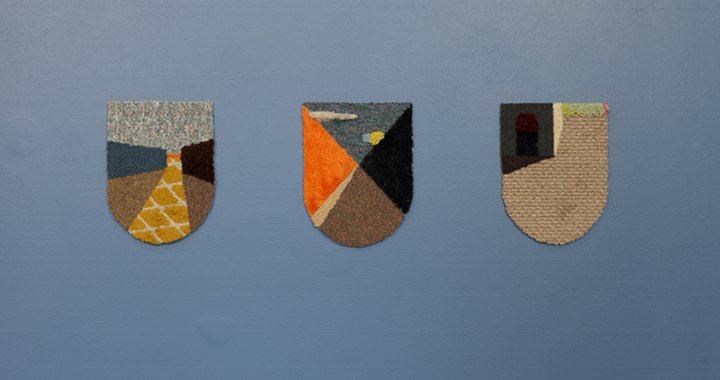
“Semiotics of coat of arms”
Express-interview with American artist August Krogan-Roley
17/09/2019
Photo: Madis Kats
From 24 August until 5 October a solo show “Empty Coats” by American artist August Krogan-Roley is on view at Kogo Gallery in Tartu.
Textile pieces that visually remind of mixed and combined fragments of contemporary landscapes have been made in shapes of coat of arms, thus the artist has opened up a subject of semiotics of historical relics. “Blending the heraldic with the optical, August Krogan-Roley’s “Empty Coats” each present themselves as a pictorial game. Littered with cues – winding roads to follow, carved out recesses to occupy, and barriers mounted to intrusive vision – they stem from the artist’s ongoing interest in the compositional mechanics of world-building,” says the accompanying text of the exhibition. We invited August Krogan-Roley to to explain more closely his interest in the concept of emptiness and his playful approach of building the world of coat of arms.

“Empty Coats” is your first exhibition in Estonia. How did your collaboration with Kogo gallery begin?
From visiting Tartu in 2017, I found out that Kogo gallery would be opening soon with an exciting program. And then a year later I saw on Kogo’s website that they had an open call for international artists, so I applied. And to my delight my exhibition proposal was accepted.
Your “Empty Coats” visually seem to remind of resized and mixed landscapes – please tell a bit more about the idea of this work.
“Empty Coats” is a body of work that plays with many compositional forms of coat of arms by displacing the heraldry of familial subjects with barren interiors and landscapes. The use of landscapes being divided by interior forces parallels concepts from these shields of recognition as identity symbols. The perspectives in these landscapes and interiors suggest an absence, much like the imbued carpet, these amalgamated images digest from their collective history. The semiotic nature from coat of arms allow these works to explore the psychological effect of symbol making and its relevancy to contemporary art.

What does the concept of emptiness imply to you?
I believe the concept of emptiness implies a symbolic meaning of something that is absent that was once present. I also believe this can equally be read as holding positive or negative connotations depending on perspective. But with this body of work, the “Empty Coats” are trying to investigate the pluralisms of symbols and how the histories of coat of arms have impacted the way we interpret cultural forms of branding and identity.

You’ve found inspiration for these series of work from the organization of pictorial space found in the medieval coats of arms. What is it that particularly attracts you to this topic?
The divisions of space within medieval coat of arms inspired me to use their visual framework of composition as a means to describe contemporary narratives through comforting shields. The silhouetted outer shapes inform the pictorial spaces within these shields, which allows my imagery to distort the meaning of interiors and exteriors and make ambiguous metaphors for coat of arms as symbols. “Empty Coats” play with pictorial space in coat of arms through a semiotic lens to illuminate human nature’s preoccupation with symbol-making. I also find the compositional aesthetics of these branding methods to be very beautiful and I’m interested in how they display a vivid relationship with the canon of painting from subjectivity to abstraction and beyond.
The exhibition is accompanied by your book “Empty Coats”. How did you come to the idea of making a book and why did you think it was important to dedicate it directly to the subject discussed in this exhibition?
I started collaborating with Lugemik in 2018 after a meeting with Indrek Sirkel and Anu Vahtra in New York. The project evolved from a body of work that seemed timely with the production of Empty Coats exhibition at Kogo gallery and that making a book to show more perspective on this series could open a greater discourse on semiotics of coat of arms.
